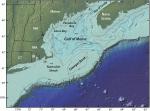Research efforts by scientists involved in the NOAA-funded Gulf of Maine Toxicity (GOMTOX) project, have led to enhanced understanding of toxic algal blooms on Georges Bank. This new information, coupled with an at-sea and dockside testing protocol developed through collaboration between GOMTOX and U.S. Food and Drug Administration (FDA) investigators, has allowed fishermen to harvest ocean quahog and surf clams in these offshore waters for the first time in more than two decades.

An elevated area of the sea floor between Cape Cod and Nova Scotia, Georges Bank is one of the best fishing grounds on Earth. For decades scientists speculated the blooms on Georges Bank were fueled by coastal blooms in the Gulf of Maine, but new research suggests the population of toxin-producing algae on Georges Bank occupies a distinct niche. (Illustration by Jack Cook, Woods Hole Oceanographic Institution)
The shellfish industry estimates the Georges Bank fishery can produce up to 1 million bushels of surf clams and ocean quahogs a year, valued $10 – 15 million annually. “There is a billion dollars’ worth of shellfish product on Georges Bank that is property of the United States but that can't be harvested because of the threat of toxicity, and 99.9% of the time, it is good wholesome product,” says Dave Wallace of North Atlantic Clam Association and a GOMTOX participant. “In an unusual and unique partnership, we worked with GOMTOX scientists, the FDA, and the states of Massachusetts, Rhode Island, New Jersey and Delaware and now that huge resource can go into commerce, which helps the entire country.”
“We are extremely pleased that research NOAA-funded can provide such an economic boost to New England shellfisheries,” said Robert Magnien, director of NOAA’s NCCOS Center for Sponsored Coastal Ocean Research.
An elevated area of the sea floor between Cape Cod and Nova Scotia, Georges Bank is one of the best fishing grounds on Earth. But since 1990, it has been closed to harvesting of surf clams and ocean quahogs after harmful algal blooms (also referred to as “red tides”) caused paralytic shellfish poisoning (PSP) that sickened fishermen. For decades scientists speculated the blooms on Georges Bank were fueled by coastal blooms in the Gulf of Maine.
More recent research by GOMTOX investigators, however, has shown that Georges Bank is home to a separate and distinct population of the toxic algae.
“We thought the Georges Bank population was just the little toe at the end of the coastal population, but it’s not. It is separate, and it occupies a distinct niche from the rest of the Alexandrium in this region,” says Dennis McGillicuddy, a scientist at Woods Hole Oceanographic Institution and a member of GOMTOX. “This was a big surprise to us.”
Read the full story at http://www.whoi.edu/news-release/Georges_Bank_fisheries.
Photos/Multimedia Gallery Available: http://www.businesswire.com/multimedia/home/20130410006311/en/
Contacts:
Stephanie Murphy, 508-289-3340
media@whoi.edu
